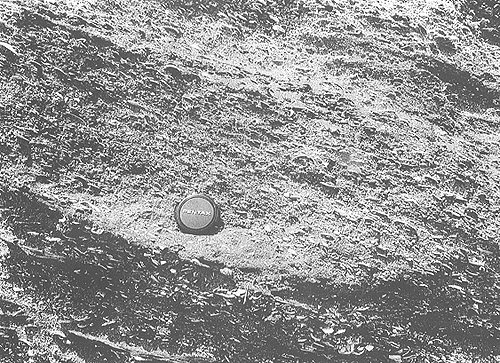
Tractive shell beds
Plate 67

Tractive shell beds
Plate 67
The sea has a tremendous amount of energy, part of which is spent in transporting sediment. It can happen that waves and currents are powerful enough to entrain coarse particles, but these are not available. Pebbles can be brought to the sea by rivers and glaciers, but remain rather localized near river mouths and other point sources. Far from them, the hard parts (shells, skeletons) of marine benthic organisms can play the hydraulic role of pebbles. They are removed by erosion, especially during storms, and redeposited in the same or a different environment. Organic, or skeletal rudites can thus accumulate; they have received a variety of names in geological literature, including shell beds and coquina beds.
The most violent storm events transport and deposit shells and their fragments in mass. Evidence of mass transport is given by the structureless and disorganized character of the deposit: lamination is lacking, particles are randomly oriented and packed, etc. Disorganized coarse sediments are also qualified as chaotic.
The shell beds shown in the picture are not massive but tractive, as indicated by two features: 1) the crude layering emphasized by the alignments of shells, and 2) their convex-up orientation.
The shells are mostly disarticulated valves of bivalve mollusks. Were they brought into suspension by a massive flow, either turbulent or laminar, a haphazard arrangement would appear upon deposition (or "freezing"). Under the effect of tractive motion, on the other hand, they assume a stable position on the bottom, as to offer a minimum resistance to fluid stress; this implies a consistent orientation, statistically speaking, and that is what is seen in this outcrop. The shells are not only streamlined but well aligned in thin beds or pavements suggesting wave rather than current action. Unidirectional currents tend, in fact, to leave coarser particles more scattered between the finer ones.
Pliocene Red Craig Formation, Norwich, East Anglia, U.K.
Displaced organic remains are said to be reworked; when they are redeposited in a sediment of about the same age as the original one, geologists speak of intraformational reworking. In situ reworking can also occur, when, for example, normal waves erode, wash and sieve the top of a storm deposit; the term modification is here preferred for this process, and it has already been discussed.
Turbulence caused by storms, and gravity are the most common agents of reworking; shells can be entrained by sediment gravity flows at the heads of submarine canyons and along the outer slopes of organic reefs. They are thus laid down at a greater depth with respect to the living place of the organisms. Water motion caused by storms, sometimes with the help of tidal currents, accumulate the skeletal remains in shallower areas (shelf, beach) and in protected water bodies (bays, lagoons).
To understand if, and how much, fossils have been reworked, one can look at their state of conservation: the more fragmented and worn they are, the clearer is the evidence of transport. Attention must be paid, however, to the fact that gravity flows, such as debris flows and turbidity currents, keep the particles suspended, which reduces the attrition. Delicate remains can thus be preserved in spite of transport distances that are often enormous. Paleontology provides the most reliable criteria for identifying reworked organisms by checking the coherence of the assemblage in terms of age and ecology (incompatible forms are sorted out and become the signature of reworking).
| Photo: G. G. Ori 1970. |